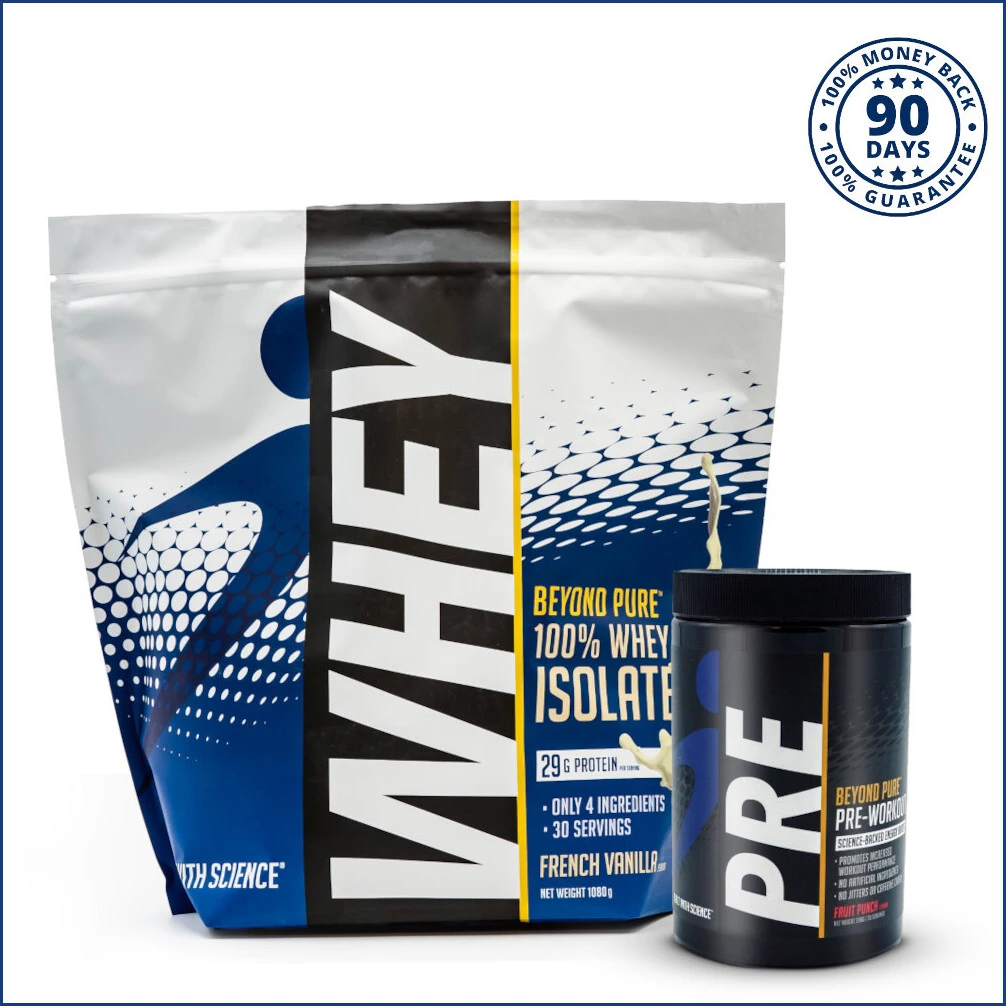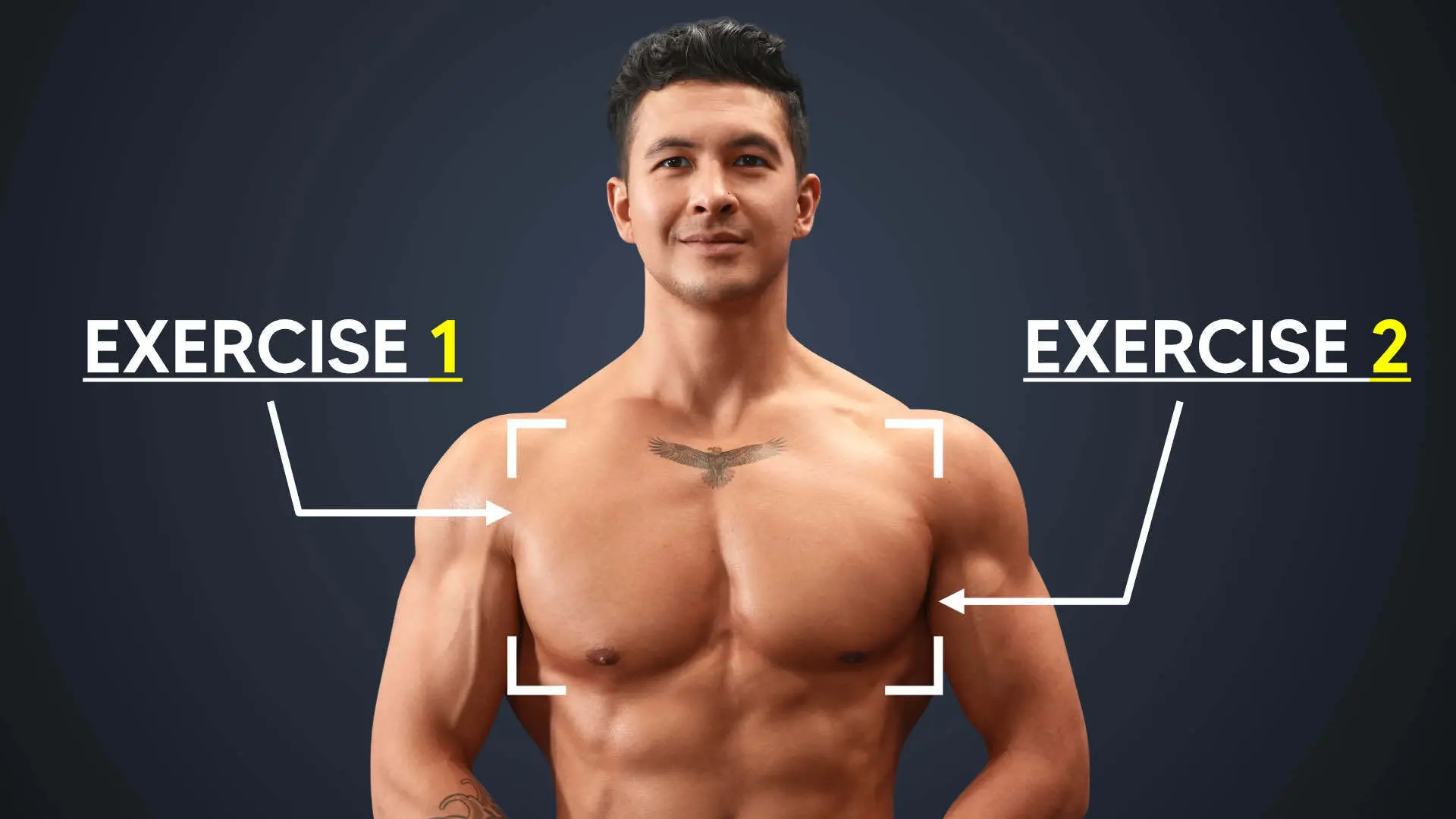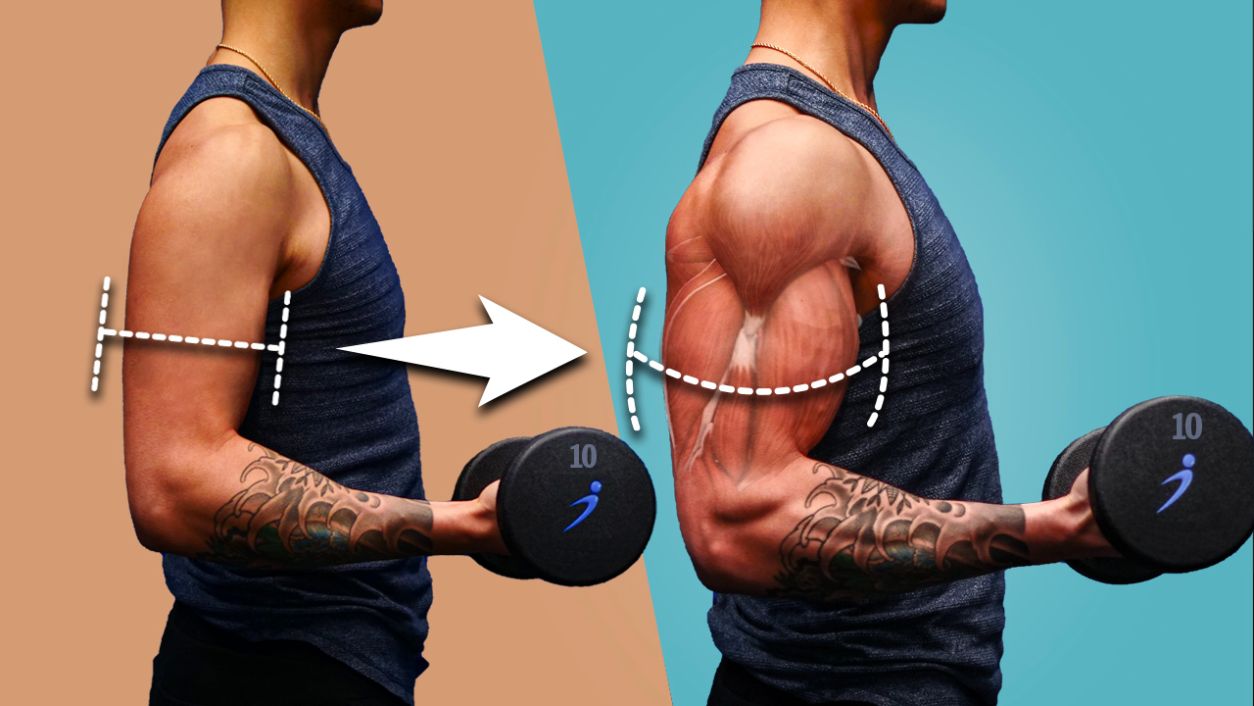
5 Progressive Overload Techniques To FORCE Muscle Growth
Stagnating gains? Or, worse still, haven't noticed any muscle growth? There's likely one thing you're failing to do: progressive overload. Here, I show you the 5 techniques guaranteed to level up your muscle growth.
For a muscle to grow, you need to continuously challenge them with more than they’re used to. That's the principle of progressive overload. But as simple as this sounds, most people’s workouts don’t accomplish this. Sure, they’ll get a good pump and sweat out of their workouts. But, unfortunately, they aren’t actually doing much to signal their muscles to grow over time.
To better explain this, let’s take a quick look at the science behind progressive overload, and the process of muscle growth. In other words: what you truly need to make a muscle grow.
Before that: if you're looking for a training program that'll take care of all the factors necessary for optimal weight loss (training, nutrition, and, of course, progressive overload!), I've got just the thing for you. Every BWS program is designed to help you transform your physique in the most time-efficient manner. And best of all? It's all rooted in science. For more information on how BWS programs can help you to look better - FAST:
Click the button below to take my analysis quiz to discover the best program for you:
↓
The Importance Of Progressive Overload For Muscle Growth
First things first. What causes muscle growth? So, let’s say we just finished a workout. Immediately after, our muscles don’t actually get stronger. In fact, they become temporarily weakened from the damage we put them through. In fact, It’s not until after a few days of proper recovery that they adapt to the damage we put them through. And that's the point where they'll come back bigger and stronger than they were before.
Why? Well, that's because they want to be better prepared for the next workout we put them through. However, there's a caveat. No matter:
- How good of a pump you get OR
- How much you sweat
... If you aren't incorporating progressive overload in training (i.e., providing your muscles more of a challenge than the previous session), then the muscle will have no reason to grow. And you can bid farewell to muscle gains.
It will simply maintain its current size and strength. Or, in some cases. even start to become smaller and weaker. For consistent gains over time, your workouts need to be designed such that they literally force your muscles to grow every single session. That's where the principle of progressive overload comes in. In other words: muscle growth requires progressive overload.
But how, exactly, should you do progressive overload to boost muscle growth? I'll show you the 5 ways you can do so below.
How To Progressive Overload
#1: Increase Weight Lifted (Load)
Increasing the amount of weight lifted is the method most people rely on to do progressive overload. It's quite straightforward to apply it.
Let’s say you can currently bench press 100lbs for 8 reps. Next week, you might try to increase the load and do 110lbs for 8 reps. This would create a new stimulus for your muscles to have to adapt to and grow from.
Now, if you’re a beginner, this method of progressive overload will be your bread and butter to help you make gains quickly. You’ll likely be able to add 5-10 lbs to the bar every week - especially on your main lifts like the bench press, squat, and deadlift.
That said, let's go back to our previous example of bench pressing 100lbs in week 1, then adding 10lbs of weight every week. Do the math, and theoretically speaking, you should be benching 620lbs by the end of the year.
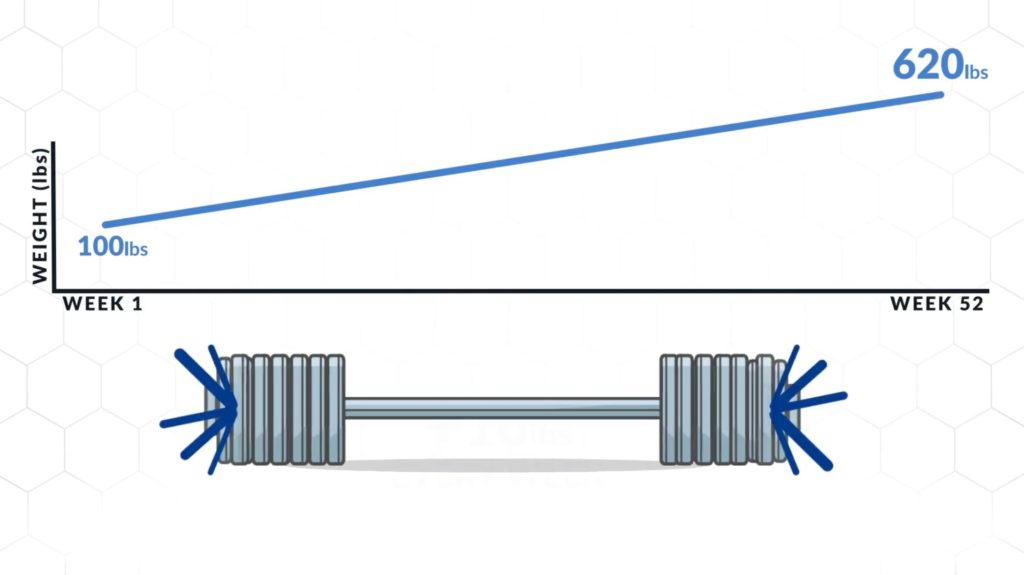
As cool as that would be, the truth is that neither:
- Myself OR
- Alex OR
- Our record-breaking Built With Science coach (who can bench press over twice his body weight!)
... is anywhere close to that. And this is where people get stuck.
They rely only on adding more weight as their method of progressive overload to stimulate muscle growth. Thus, explaining why they eventually get stuck in a plateau.
To breakthrough, we have to get more creative with how to progressive overload (i.e., challenge our muscles). This is where our next point comes in handy.
#2: Up The Rep Count
When applied properly, adding more reps is another great progressive overload technique to force your muscles to grow. The way this works can be illustrated with a simple math equation.
Let's say I can bench press 100lbs for 10 reps one week. I can multiply those numbers and calculate that I have lifted 1000lbs total across that set. If next week, I go to the gym and lift that same weight for 11 reps, I will have lifted 1100lbs across that same set. This means I’ve technically lifted 100lbs more than last week. And this is essentially similar to adding more weight to my training; it'll create a new stimulus for your muscles to grow.
What's The "Rep Limit"?
But how high in reps can you go while using the same weight? Well, you can find the answer in this 2017 meta-analysis. As long as you’re continuing to push hard, you can keep the same weight and increase all the way up to 30 reps. You'll still get the same growth compared to adding more weight.
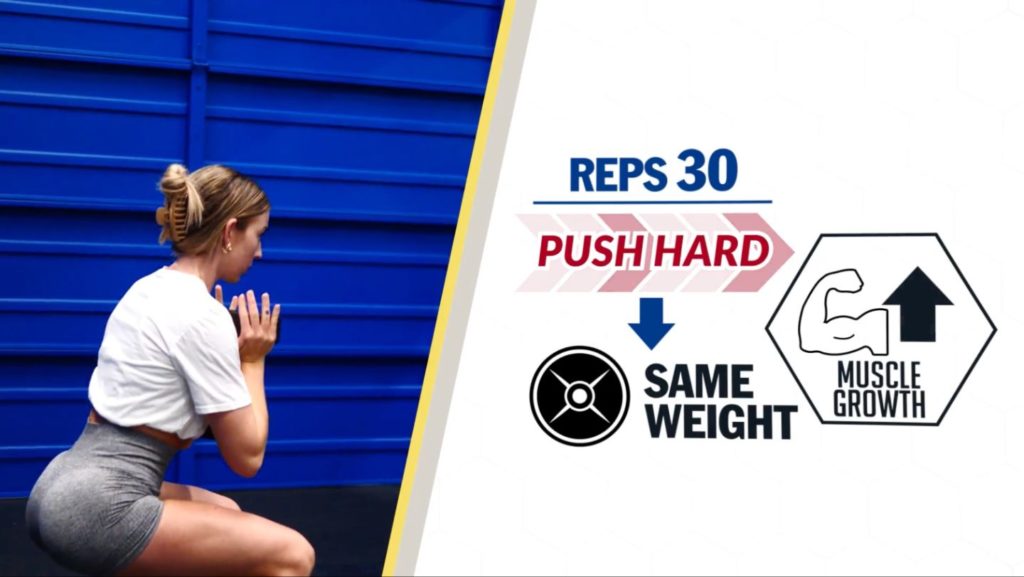
This is helpful if you:
- Only have limited equipment OR
- A nagging injury - and can't increase the weight on your lifts even if you wanted to
However, for those who do have access to more weights? What we’ve found to be most effective - and teach in our Built With Science programs - is a special progressive overload technique called double progression.
This is a system that utilizes both reps and weight to ensure week by week you’re forcing your muscles to grow.
The way it works is simple. Let’s say you’re doing 3 sets of squats for 8-12 reps with 100lbs. In week 1, you could do 8 reps for each set. Next week, you’d aim to do 9 reps each set. If that went well, you’d continue doing that until you were able to do 12 reps for all 3 sets. At that point, rather than continuing to increase the reps, you could add 10 lbs and restart the process by going back down to 8 reps.
However, again, this often only works for so long. What happens when you get stuck unable to add more weight or do more reps? Here’s where another most often overlooked form of progressive overload can come into play.
#3: Increase The Number Of Sets You Perform
The next progressive overload method has to do with how many sets you perform.
Let’s say you’re trying to build up your biceps. Adding sets can be as simple as going from 3 sets of 12 one week to 4 sets of 12 the next week.
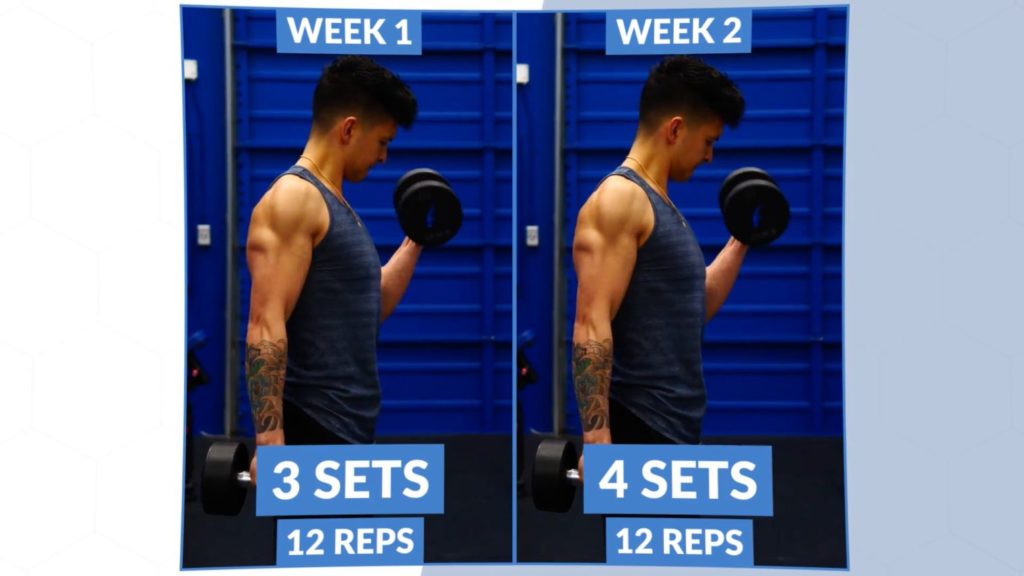
Let's go back to the simple math equation we used earlier. So, if we were curling 40lbs in each hand, then each of our biceps would be lifting 480 more lbs in the second week by just adding that one set.
It’s a simple way to add a massive amount of training volume to your program. And is a progressive overload technique we frequently use in our more advanced Built With Science programs to help bring up lagging muscle groups.
Be Mindful Of Diminishing Returns
However, you need to use this method sparingly.
Based on the literature, we know doing at least 10 sets per muscle group per week nearly doubles the amount of gains you would get from doing 5 sets per muscle group per week. But there comes a point of diminishing returns when you get into the 20-30 set zone. A good rule of thumb is to increase volume no more than 10-20% per week.
So, if you’re currently doing 10 sets of chest per week, for example, but are stuck unable to lift more weight or do more reps, next week you could still use the same weight and do the same amount of reps - but just add 1 extra set to each exercise. And you should continue doing so every week.
Then, once you get to the 20-30 set zone, or just begin to feel quite fatigued, you can cycle back to the original program you started with.
Admittedly, this method does have its benefits. But it is also quite taxing on the body. And can make your workouts considerably longer.
So, that's where the next two methods of progressive overload come in. Both are ways you can continue forcing your muscles to grow while:
- Lifting the same weight AND
- Doing the same number of reps and sets weekly
Surprised by all the new training "best practices" you're learning in this article? Never knew that there were so many subtleties to priming your muscles for growth? Well, to be honest, this is just the tip of the iceberg. There are so many more things you need to know about maximizing your gains. And the best place to start? It's with the Built With Science programs:
Click the button below to take my analysis quiz to discover the best program for you:
↓
#4: Slow Down Your Reps (Tempo)
Tempo refers to how fast or slow we lift weights.
If we slow down our reps, we can increase the amount of time that tension is placed on the muscle to stimulate more growth.
This is especially effective for exercises involving smaller, weaker muscle groups (e.g., shoulders) like lateral raises. Why? Well, that's because often in these exercises, adding just a little bit of weight disproportionately increases the difficulty. Slowing down your tempo is also an effective progressive overload technique for bodyweight exercises (e.g., push-ups and pull-ups) where adding weight may not even be an option.
However, you want to avoid going too slow. Doing so can provide the opposite effect and start to hinder muscle growth rather than boost it. Based on the recommendations of Dr. Brad Schoenfeld who ran a 2015 meta-analysis analyzing the effects of tempo on muscle growth, it seems that we can slow down our reps up to about 6 seconds total.
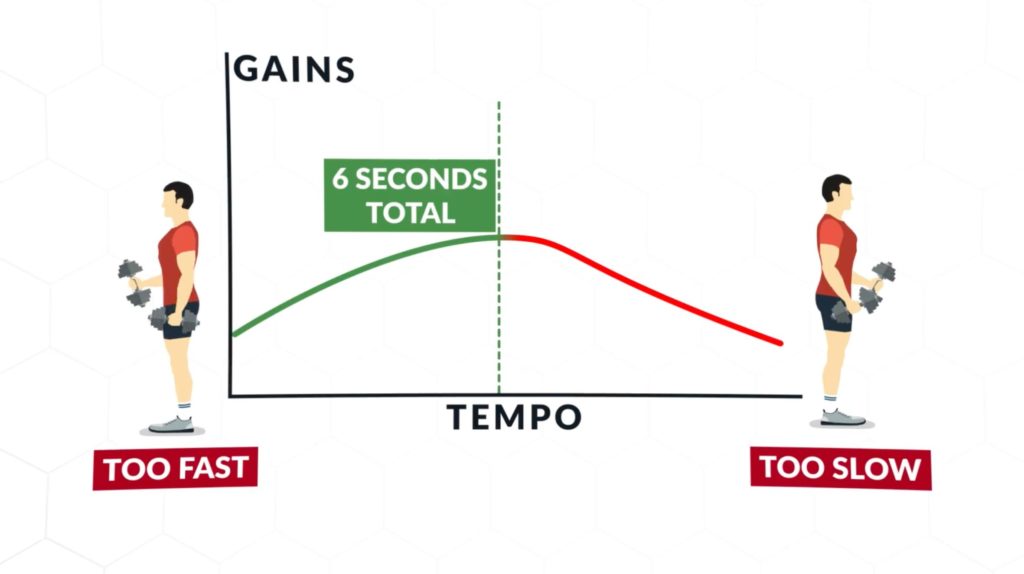
So, for example, let’s say you’re doing 20lb lateral raises. And for each rep, you usually take about a second on the way down and a second on the way up. Rather than doing more weight, reps, or sets to stimulate growth, you could instead just slow down your reps by 1 second every week. You could apply this until you reach 3 seconds on the way down and 3 seconds on the way up. This is the point where the reps would get too slow. And is when you’d want to apply another form of overload such as increasing the weight up to 25lbs.
#5: Clean Up Your Form
Oftentimes, when people think they are challenging their muscles more by adding more weight to their lifts, they really just end up compromising their form in the process. As a result, despite using a heavier weight than they were previously, their target muscles aren’t working any harder. Instead, realize that if you do the same workout you did the week before, but you performed your exercises with:
- Better control
- Less momentum AND
- More activation of your target muscles
... Then you would have successfully achieved progressive overload.

Better form involves relying more on the target muscles. And will, thus, result in growth even if all other variables remain the same.
Now, this method may not catch your eye as much as some of the others on this list. But the truth is that many of you reading could easily stimulate a significant amount of growth for all your muscles by just cleaning up your form with your exercises.
Even advanced lifters still spend time analyzing and tweaking their form because we know that any other method of growth will be meaningless unless your form remains intact.
Takeaway
Now, as for which of these 5 methods is best - and will provide the most growth? The truth is it depends. More specifically, it depends on your:
- Level of experience
- Equipment availability AND
- If there's certain type of plateau you're stuck in
So, the best way to find out which method works best for you is to experiment with them. See what works best for you.
But if you’re looking for a step by step program that takes care of all the guesswork for you and ensures that week by week you’re challenging your body in the right way to consistently build muscle and lose fat, just head on over to builtwithscience.com and take our analysis quiz to find out which of our programs is best for you and your body:
Click the button below to take my analysis quiz to discover the best program for you:
↓



